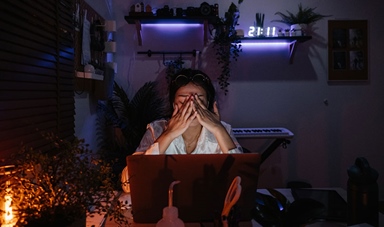Loading component...
At a glance
Before the pandemic, many of us considered working from home a luxury. No rush-hour commute, no dress-for-success, maybe even time for a leisurely lunch.
A recent McCrindle Research survey showed many Australians were eager to embrace the perceived freedom of working from home or remotely. More than three in four (78 per cent) agreed it would become the new normal and said they would stay longer with their employer if they were offered more remote working or flexible working conditions (76 per cent).
The problem for many of us, however, is that now we’ve had a taste of working from home, it’s not quite as idyllic as we imagined.
Stationed in front of the computer while family life goes on around us or, alone and isolated from colleagues; checking text messages and emails into the night; having to manage relationships with colleagues and clients through Zoom meetings and apps like Monday, has contributed to many of us feeling exhausted and disengaged.
“It is a case of be careful what you wish for,” says lead clinical adviser for Beyond Blue Dr Grant Blashki, who was confined to home during the lengthy Melbourne lockdown. The greatest risk, he says, is that work seeps into our personal lives and the lines become increasingly blurred, a work/life imbalance fuelled by poor work/home boundaries and a lack of self-care.
The loss of self
When we spent a day at the office pre-Covid, most of us didn’t give much thought to stepping away from our desk for a coffee break, or a catch-up around the watercooler.
Now, with technology enabling contact 24 hours a day, many of us feel the need to be continually “switched on” and “tuned in”. It is this “availability anxiety” that is causing us to skip breaks essential to mental and physical wellbeing and put ourselves last in our work diary, according to Blashki.
“The intrusiveness of technology means colleagues have more access to us than ever before,” he says. “By accident, many of us have made our home our workplace, and the existing stress of workloads for some employees has been amplified.”
People leadership and workplace resilience expert Michelle Bihary believes: “What we have lost is those ‘transition’ moments. Now we’re either working or managing at-home responsibilities and there is no time when we are not a partner, a parent, a carer or an employee.”
Bihary, author of Leading Above the Line, says it is those moments that are crucial to connecting with ourselves.
“For many of us the commute, for instance, was a time to listen to podcasts, reflect, or connect with people. For leaders, informal time at the office was also a chance to get a real sense of where their people were at, and what they were needing. Now leaders need to shift some of their management skills to a more fluid working environment.”
Scaffolding that provides support
Now is the time for those who oversee teams to consider how they can connect with employees and the part they play in inspiring productivity, encouraging skill development and giving positive feedback, says Bihary.
“Leaders need to provide scaffolding that supports the working-from-home framework that has, on the positive side, created incredible opportunities, autonomy and agency.”
Blashki agrees: “In a mentally healthy workplace, people need clear job descriptions, manageable workloads and a culture that recognises time off. It is in [an] employer’s interest to set that up well, otherwise burnout is a real risk.”
On the other side of the equation, employees who are feeling stressed through a lack of boundaries need to ask for guidance about their working conditions and role.
They also need to assume responsibility for taking charge of their own routine, says Blashki, and that includes managing colleagues’ expectations regarding communication.
“If you answer your phone at all hours, it will gradually become the norm.”
He suggests setting up signals and symbols that we are in work mode – getting dressed professionally for work, controlling who has access to texting and phoning us and at what time, and strictly defining when we are working and not working.
A signal at the end of the day, such as a walk or run, a meditation session, or even a glass of wine, may be mentally healthy. But it can be anything that is meaningful to you that allows your mind to switch off, the computer to be shut down, and the door to your home office closed.
Planning not just lunch breaks but social get-togethers or holidays is also essential, says Blashki because, otherwise, work will expand to fill the gaps. Eating at your desk is never recommended; regular mini-breaks and planned leisure time is important.
Bihary, who recently spoke at a CPA Virtual Congress on Reimagining Work Life (Dis) Integration, says surviving the new working normal also requires developing some mindfulness skills. Rather than multi-task, or ruminate about the past or future, have your attention on what is going on right now, she says.
“You need to learn to manage your mind and train yourself to be where you are. That skill is amplified now.”

